Bass tuba
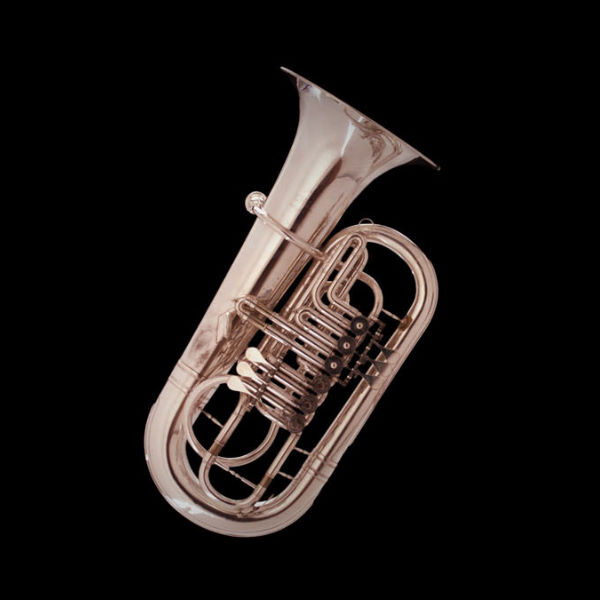
Brief description
- Name: Bass tuba in F
- Spelling
- German: Basstuba in F
- French: tuba basse en fa
- Italian: tuba bassa in Fa
- Classification: Aerophone, lip-vibrated instrument, brass wind instrument. Belongs to the valved bugle-horns family
- Material: Brass, gold brass, nickel silver, gold lacquer
- Mouthpiece: Deep cup mouthpiece
- Tubing: Length 350-400 cm, conical along entire length
- Bore: Very wide, inner diameter 17.3-19.5 mm
- Valves: Four to six valves (lowering pitch by 1, ½, 1½ steps, fourth-valve, fifth-valve - this can also be a compensating valve with a wide whole step. The 6th valve is a compensating valve with a wide half step)
- Bell: Rim diameter 35.5-41.9 cm
The tuba is currently used in four tunings: the bass tuba in F and Eb, and the contrabass tuba in C and Bb. In Austrian and French orchestras tubas in F and Bb are used, the contrabass tuba in Bb being found primarily in opera orchestras. In some regions of Germany and in Scandinavia, the United Kingdom and the USA the C tuba with four valves is common as a kind of all-round instrument: it is played not only in the orchestra but also in chamber music and as a solo instrument.
Tubas are made in four different patterns and have a variety of names: there is the oval form; the sousaphone (rounded, made of fiber-reinforced plastic with a forward-facing bell; the instrument is hung over the shoulder for the purposes of marching); the helicon (round form) and finally the tuba form (upright with bell facing upward). There is also a wide variety of sizes, bore profiles and valve mechanisms.
The bell passes the musician's head either on the left or the right, depending among other things on the type of valves the instrument has: Périnet valves and rotary valves are equally common. The double tuba has a valve which enables the player to alternate between two tunings - it is a combination of a bass and contrabass tuba.
The bass and contrabass tubas are the largest and lowest-pitched brass instruments not only in the orchestra (where the tuba player sits together with the trombone section) but also in wind band and military music. Beside the tubas in Eb, C and low Bb, other instruments of the valved bugle horn family covering all pitches (e.g., cornet, flugelhorn, euphonium) are common in wind band and military music, whereas in modern orchestras the bass tuba is the only instrument of this kind in use.
Valves
Périnet valve
Also: piston valve. Patented in Paris in 1838 by François Périnet as a further development of the piston valve that was first presented by Heinrich Stölzel in Berlin in 1814. Along with the rotary valve, this is the most widely used brass instrument valve today.
Rotary valve
This valve was developed in Vienna by Joseph Riedl in 1835 and is now the most commonly used valve on brass instruments along with the Périnet or piston valve.
History 1 - baroque to 19th century
The term tuba is derived from the Latin word tuba (tuba) and in classical antiquity described a cylindrical lip-vibrated instrument (the Roman trumpet), which saw service principally as a signaling instrument. However the name, which found itself attached to a wide variety of instruments over the centuries, was the only thing this archaic instrument had in common with the modern tuba.
Baroque and classical music - the tuba's distant relatives
The tuba curva, a brass instrument made in Paris in 1791 for the festivities following the French Revolution, was modeled on the Roman trumpet and is regarded as a forerunner of the modern tuba. This instrument had a very powerful sound, no valves or keys and a range limited to the lowest naturals.
Another distant relative of the tuba is the serpent, a conical, wooden instrument about 213 cm long with six finger-holes and a cup mouthpiece made of ivory or horn which appeared in the 17th century. It was placed beside the choir in French and English churches to support the voices in full passages, lending particular strength to the male voices. According to reports the serpent blended with the voices even more effectively than the organ did, although Berlioz was one who did not share this view. In his opinion the instrument's sound blended only poorly with the choir and was not suitable for sensitive ears.
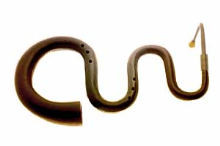
Serpent in C, presumably around 1970, Christopher Monk, Surrey, England (Musikinstrumentenmuseum Schloss Kremsegg, Austria, Streitwieser collection)
One of the serpent's weaknesses was the fact that it was not possible to play any scale accurately because notes a step apart were played using the same fingering, pitch alterations being possible only by varying lip-tension - up to a fourth. Changes in volume also presented difficulties.
In 1825 a serpentone was in use at La Scala in Milan, which was nothing unusual in 19th century Italy. The premieres of Handel's Fireworks Music (1749), Mendelssohn's oratorium Paulus (1836) and Wagner's Rienzi (1842) all featured the serpent. The instrument remained in use for around 250 years, until the 1890s.
The serpent was called for in symphony orchestras only very rarely, although it was a very common feature of oratorio festivals.
The 19th century - the century of the ophicleide
In 1810 the Irishman Joseph Halliday was granted a patent for a keyed bugle, the so-called Royal Kent Bugle. This conical instrument had copper tubing (125-135 cm long with a diameter of 12-25 mm), a very fast flare to a 15 cm wide bell and at least six keys.
This very agile instrument was used as a powerful soprano instrument for playing the melody line in brass bands, but was only seldom asked for in symphony orchestras (an exception is Rossini's opera "Semiramide", 1823). In France this instrument was called the trompette cromatique or bugle à clefs, in Germany it was known as the Klappenhorn. Because of the virtuosity of this soprano instrument it was deemed necessary to make a bass counterpart: the century of the ophicleide began.
The ophicleide, which looked like a bassoon, had conical tubing made of brass (approx. 274 cm long, as on a Bb instrument, tube diameter 12.5-35.5 mm) with several keyed side-holes. By opening the holes the air column was shortened and the pitch increased; it worked on the same principle as woodwind instruments. A number of naturals could then be played from the fundamental tone thus produced.
The range, a maximum of around three octaves, depended on the ability of the player. Intonation was very uncertain because several fingerings were possible for each note. The mouthpiece was cup-shaped, with a flat rim, the bell faced upward and had a diameter of about 21 cm. The huge volume made great demands on the breathing and the round, euphonium-like sound - which was very rugged in the bass - was very effective with brass played en masse. It also blended very well with the choir.
From 1821 until the end of the 19th century the ophicleide was widely used as a bass voice. It is called for by Mendelssohn (Midsummer Night's Dream Music, 1843, Reformation Symphony)), Schumann, Meyerbeer (Robert the Devil), Verdi and Wagner (Rienzi). Hector Berlioz required several ophicleides in his Fantastic Symphony, but was one of the first composers to develop an enthusiasm for tubas, with which he proceeded to replace the ophicleides. Today all ophicleide parts are played by the bass tuba.
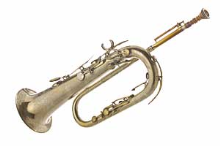
Silver valve horn in F, E.G. Wright, Boston 1854 (Musikinstrumentenmuseum Schloss Kremsegg, Austria, Streitwieser collection)
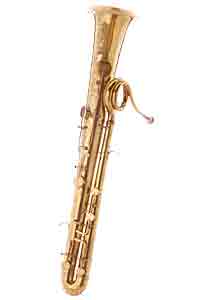
Ophicleide in C, J.H. Ebblewhite, London 1850-1854 (Musikinstrumentenmuseum Schloss Kremsegg, Austria, Streitwieser collection)
From the 1820s onward numerous bass instruments of similar construction but with different names were built; in 1829, for instance, W. Riedl made a valved instrument in Vienna which was modeled on the ophicleide and became known as the bombardon. This wide-bored instrument had a powerful tone and was still used in military bands after the advent of the tuba. The French counterpart of the bombardon was made by the industrious and well-known instrument maker Adolphe Sax (1814-1894), who in 1843 was granted a patent for a group of valved brass instruments which covered the entire tonal range: the usual names for these instruments were saxhorn, saxtromba and saxtuba and they were used mainly in military circles.
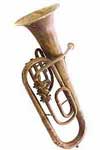
Tenor saxhorn
History 2 - the modern bass tuba
1835 - the birth of the modern bass tuba
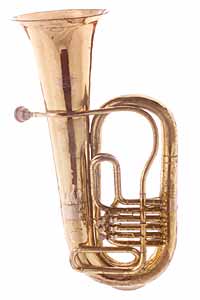
Tuba, Ant. Holy, Pilsen, Bohemia, ca. 1850/60 (Musikinstrumentenmuseum Schloss Kremsegg, Austria, Streitwieser collection)
In 1835 Johann Moritz and the trombonist Wilhelm Wieprecht (1802-1872) were granted a Prussian patent in Berlin for the bass tuba. Although valved instruments in the bass register already existed (e.g. the bombardon) this was the first instrument to bear the name bass tuba.
The bass tuba was made of brass, keyed in F and had five piston valves (“Berlin valves”). The first three valves were operated by the right hand, the other two by the left. The 1st and 2nd valves lowered the fundamental note by a whole tone and a semitone respectively in relation to the key of F; the 3rd valve lowered the instrument's tuning by a fourth, from F to C. The 4th and 5th valves lowered the pitch from C by a whole tone and a semitone (wide half step, wide whole step) respectively. The relatively narrow bore meant that the bass notes were not particularly loud or powerful.
In the course of the reorganization of Prussian military music Wieprecht introduced two bass tubas into every band, which aided the instrument's distribution and further development. Because the gap between the 1st and 2nd naturals could not be bridged on an instrument with three valves, subsequent tubas were made with four to six valves.
The fact that the bombardon and the bass tuba existed at the same time often led to confusion. Hector Berlioz described Wieprecht's tuba as a bombardon with an improved mechanism and stated that its timbre was very much like that of the ophicleide. In France, the tuba was known for a long time as the ophicléide-à-pistons. Two features distinguished the tuba from the bombardon: the wide bore profile and the valves, the new “Berlin pistons”. The following explanation helps to clear up the confusion surrounding the two instruments: the bass instrument used in military bands was called the bombardon, while its counterpart in the symphony orchestra was known as the tuba.
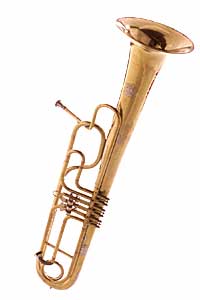
Bombardon
The introduction of the tuba solved the problem of a satisfactory bass voice in military and wind bands. Despite this symphony orchestras were slow to adopt it.
Hector Berlioz first encountered the bass tuba on tour in Germany and describes it as follows: “In Prussia the bass tuba has replaced the ophicleide; it is a large wind instrument with five rotary valves which give it a large compass in the low register. The low notes are blurred, but when two tubas double an octave apart this produces an enormous resonance. In the middle and upper registers the sound is very refined and not as flat as the ophicleide's, rich, vibrant and well-matched to the timbre of the trombones and trumpets, which the tuba serves as the bass voice.” Berlioz was one of the first composers to embrace the tuba with enthusiasm, using it in virtually all his scores in place of the ophicleide.
Gradually the bass tuba began appearing in various orchestras and by the second half of the 19th century it had been widely adopted in German orchestras.
Present day
Present day tubas have a fast rate of flare of about 1:10 to 1:20 from mouthpiece to bell. Pedals play well on account of the wide conical bore. Nowadays instruments with five or six valves are the most widespread - this number is necessary to be able to play the full chromatic scale (eleven half steps downward) and to ensure pure intonation.
The bell of the orchestral tuba faces upward. The helicon is used in wind bands and dance bands, while the sousaphone is found in American wind and military bands.
Notation
- English
- (Bass) Tuba
- Bs. Tb., Tb.
- in F
- Italian
- Tuba (bassa)
- Tb. B., Tba., Tb.
- in Fa
- French
- Tuba (basse)
- Tb.
- in Fa
- German
- (Bass)tuba
- Btb., BT.
- in F
Orchestra
Music for the bass and contrabass tubas is generally non-transposing and written in bass clef. The instrument is pitched in the bass and contrabass registers.
Notation an octave higher than the actual sound has not found acceptance, even though it is easier to read in parts. The reason for this is that the tuba often doubles the 3rd trombone and shares a staff with it.
Wind bands
In wind bands a bass tuba in Eb is used, the notation for which is subject to national variations: In Germany, Italy and England the notation is non-transposing in bass clef. In France, Belgium and the Netherlands it is transposing, with no accidentals, in bass clef (sounds a major sixth lower than written):

In Switzerland transposing, in treble clef, no accidentals. (Sounds one octave and a major sixth lower than written):

Range
Range of the bass tuba: D1 - G4
Lower register D1 - F2
Middle register F#2 - F3
Upper register F#3 - G4

Sound production

Overall the embouchure is relaxed; it is only in the high register that the lips are tensed.
Pedal tones (1st naturals) speak well on all conical instruments, although on the tuba they require an enormous amount of effort on the part of the player. Theoretically all the pedals (from F1-Gb0) can be played, but the huge demands made on the breathing mean that this is barely possible in practice: the bigger the instrument, the more difficult it is to play in the pedal region.
The number of steps by which the valves can lower the first pedal note depends on how wide the bore is: on narrower-bore tubas it is four semitones (to Db1), on instruments with a wider bore it is eight semitones (to A0). Lower notes can no longer be played and are used only from the 2nd natural.
The tuba's fast rate of flare allows overblowing only as far as the 8th natural, except on narrower-bore tubas in F, on which the 9th and 10th naturals can be produced with the help of an appropriate mouthpiece.
On tubas the ratio between bore profile and bell diameter is not constant. A tuba with a narrow bore can have a very wide bell and vice versa. This ratio is usually expressed as a fraction with the denominator 4, e.g. bass tuba in F: 4/4 size or 3/4 size. Bore profiles range in size from 3/4 to 7/4.
As a rule lower-pitched instruments have a less agile and therefore slower response than higher-pitched ones. It takes longer for the column of air in the tube to respond. Tuba players have to compensate for this late response, which they do by beginning their attack prematurely - they must continually jump the gun, as it were, and remain fractionally ahead of the conductor.
A further difficulty encountered by tuba players is the fact that they sit right at the back of the orchestra amid curtains or surfaces that absorb part of the instrument's sound. Their proximity to the timpani has a similar effect, because some of the tuba's overtones are swallowed by the sound of the timpani.
The bass tuba's range is the same as that of the contrabass tuba, which means that all the pieces commonly performed today could be performed by the bass tuba. The lowest notes are equally hard to produce on both instruments. However, the even greater richness of tone and darker timbre of the contrabass tuba mean that it is preferred for parts at this pitch level.

Playing Techniques
General
The bass tuba is a very agile instrument, far more agile than it appears.
Single Tonguing
Can be played well and fast in all pitches. Very fast scales can be played. Sharply accentuated forte blasts are difficult to maintain for long periods and are felt to be ponderous and dragging.
Staccatonotes are very homogeneous and effective played pp , comparable to the pizzicato of the double-bass.

Vibrato
Tuba players use vibrato as an acoustic trick, to simulate a supple sound where it is in fact missing. Compared to the other tones, pedals are at a disadvantage because they require a much greater volume of air. As a result the note becomes softer. By using slight vibrato, however, the note appears louder.

Sforzato
Piano-Fortepiano
Rapid dynamic intensificaton from piano to forte, then again reduction to piano.
Sforzando
Forced, short attack followed by a rapid reduction in tone intensity.

Double tonguing
Can be played with ease at all pitch levels up to a tempo of about MM 130 (4 sixteenths per quarter note 130). Rarely called for in symphonic orchestra literature.

Triple tonguing
Can be played with ease up to a tempo of about MM 150 (4 sixteenths per quarter note 150). It goes without saying that the notes have a slower response the deeper they are. The performance of fast playing techniques such as triple tonguing thus reaches the limits imposed by physics. Rarely called for in symphonic orchestra literature.
Flutter tonguing
Can be played easily, but is rarely required.

Glissando
A genuine glissando is not possible, but something approaching a glissando effect can be produced by half closing the valves.
Trills
Trills are possible and can be performed well using the valves. Although the effect they produce is good they are found only rarely in orchestral literature.

Mute
Mutes are used to reduce the volume. They also brighten the sound. Sufficient time must be permitted for the insertion of the mute, due to its size. Arnold Schoenberg's monodrama Erwartung features flutter tonguing with mute, which creates a very gentle effect.

Legato
Legato playing makes great demands on the breathing and for this reason the length of phrases must be chosen with care. Large leaps can be performed very well in legato. A staccato-like articulation following an accentuation is also easy to perform and is in keeping with the technique of playing a bass instrument.

Sound characteristics
Round, smooth, calm, velvety, hearty, robust, unobtrusive, ponderous, sustaining, gentle, soft, soothing.
Lower register
D1 - F2
Although the pedal tones speak thanks to the slightly wider bore they are difficult to play and sound very ponderous. For this reason they are only scored pianissimo together with other instruments. The overall effect of the low notes is soft and unobtrusive. The tone is not penetrating, but nevertheless projects very well.
Middle register
F#2 - F3
Very full-sounding in soft legato phrases. It is the notes within this compass that are used most often.
Upper register
F#3 - G4
A very loud and powerful tone is possible at this level which can hold its own in tutti passages.
Sound Combinations
The bass tuba is a bass and contrabass instrument. One of its principal tasks is the doubling of other bass instruments, either in unison or an octave lower. Especially in tutti passages its role is to provide a firm fundamental bass. Forte pedal tones are generally played solo and are only combined with other instruments for pianissimo playing.
In especially large brass sections, for example with six or eight horns, two tubas are used, one of them playing the higher compass, the other the lower. In works which place particularly great demands on the tuba, two tuba players often share the task, relieving each other by turns.
Tuba + Brass instruments
Tuba + tuba
In brass bands the bass tuba often doubles with the contrabass tuba, playing an octave above it. This produces a massive sound.
Tuba + trumpet
Poor blending with the trumpet. The bass tuba serves as the bass to the brass.
Tuba + horn
Good tonal blend, since the tuba's timbre is closely related to that of the horn. Often doubles the 4th horn.
Tuba + trombone
Are similar in force and complement each other, despite their disparate timbres. As bass voice to the trombones often plays the 4th trombone part. Doubles the 4th trombone. In keeping with its character the tuba also provides the bass voice for the entire brass ensemble.
Tuba + woodwinds
Tuba + flute, oboe
No tonal blend. In Benjamin Britten's violin concerto the tuba and the piccolo play a solo.
Tuba + bassoon, contrabassoon
Doubling, also in octaves, of the bass voice with the contrabassoon.
Tuba + strings
Very good blend with the double-bass. The staccato is comparable to the pizzicato of the double-bass. In early phonograph recordings a bass tuba with a front-facing bell was used to double the double-bass, which improved the quality of the recording.
Symbolism
The bass tuba symbolizes a large, lone creature, which keeps itself in check most of the time - it could drown out the orchestral tutti. The mellowness, softness and roundness of its sound seem to convey more a feeling of security than one of immediate danger. Above all the tuba symbolizes the voice of a very large beast that is quite simply there and has no need for intimidating gestures because of its huge size. The voice of the dragon (Wagner: Siegfried) or the bear (Stravinsky: Petrouchka) can only be suggested by the tuba. Something large and clumsy can be equally well depicted - the apparent incompatibility of size and agility serves as a source of humorous effects.
Repertoire (selection)
Arrangements for tuba + chamber ensemble
Various well-known classical pieces were arranged for tuba and accompanying chamber ensembles:
George Frideric Handel
Johann Sebastian Bach
Arcangelo Corelli
Antonio Vivaldi
Henry Purcell
G.B. Pergolesi
Joseph Haydn
W. A. Mozart
L. van Beethoven
Franz Schubert
Georges Bizet
Charles Gounod
Richard Wagner
Johannes Brahms
Pyotr I. Tchaikovsky
Edvard Grieg
Modest Mussorgsky
Richard Strauss
Gabriel Fauré
Leonard Bernstein
Eugène Bozza
Jenő Takács
Paul Hindemith
- Sonata for tuba and piano (1941)
Solo tuba + orchestra
- Ralph Vaughan Williams
- Concerto in f minor (1954)
Solo tuba + wind orchestra
There are numerous concert pieces for solo tuba and wind orchestra.
Solo tuba
Appears mainly in contemporary works (Boguslaw Schäffer).
Tuba in jazz
Is used frequently in Dixieland and Swing ensembles.
Tuba as an orchestral instrument
Is called for in orchestral scores since Berlioz, Wagner, Brahms, Bruckner, Mahler, R. Strauss, Ravel.
